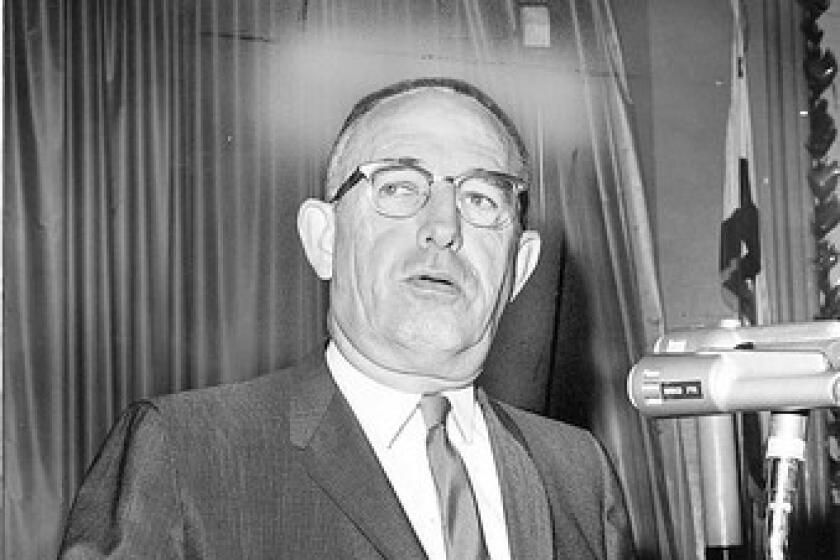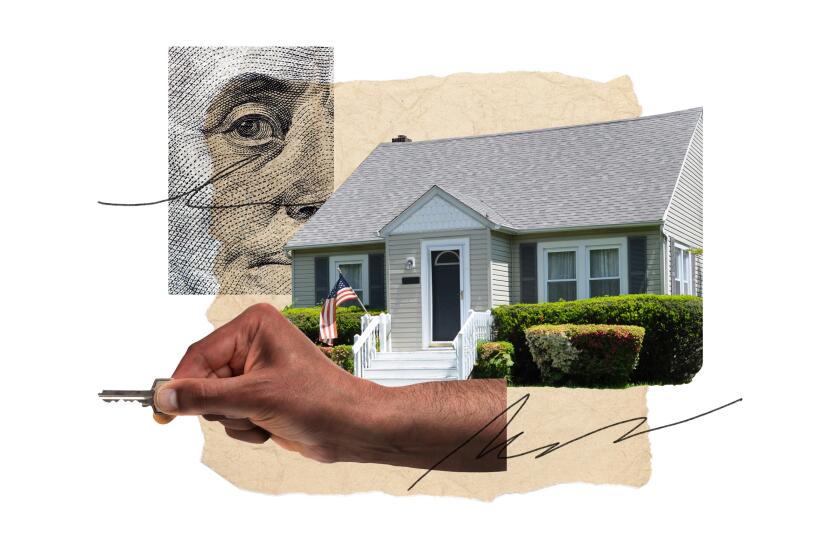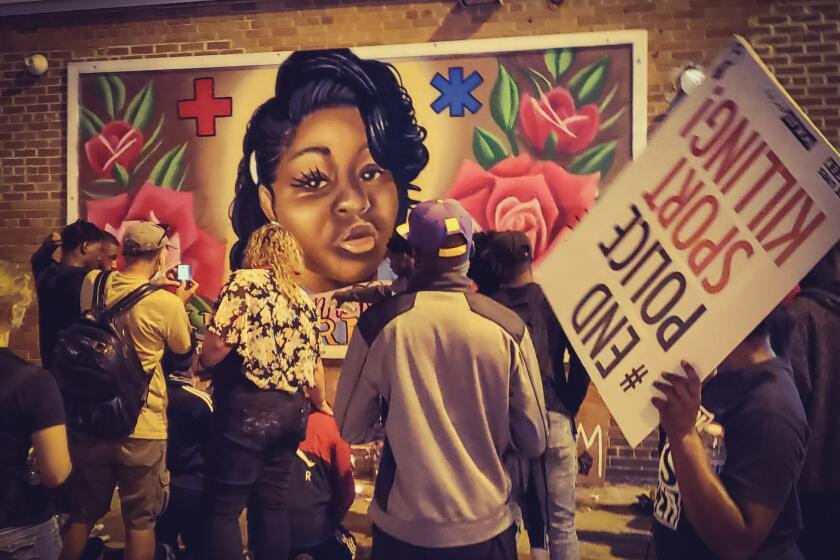Opinion: One tragic night four decades ago forced San Diego to grow up

By the mid-1980s, San Diego had exploded into one of the 10 most populous metropolitan areas in the country, but most residents simply refused to believe it. For them, it was still a funky little beach town — one with an unofficial slogan: “We are not L.A.” Thanks to the stable economy supported by military bases, tourism and real estate, much of San Diego felt immune to urban decay.
That is, until March 31, 1985, when two white San Diego police officers and a civilian observer followed a pickup truck with seven young Black men up a long dirt driveway in the Southeast section of the city. Everything changed because of the tragedy that ensued: The driver of the truck, 23-year-old Sagon Penn, grabbed an officer’s gun and shot the civilian and both officers, killing one. The shooter then stole a police car and ran over the surviving officer.
I’ve lived in L.A. during the Watts riots, the beating of Rodney King and the death of George Floyd. Books about these times, such as Gary Phillips’ “Ash Dark as Night,” help me understand them.
Many San Diegans were shocked. They shouldn’t have been.
For more than a decade, warnings about a looming crisis had been coming from two groups: members of the Black community in Southeast San Diego and the cops responsible for policing the area.
While parts of San Diego exceeded all other large American cities in economic growth, some communities had been left behind. Black residents had been redlined into the Southeast. Freeway construction carved up once-vibrant residential neighborhoods and commercial districts. Changes in city zoning laws permitted the building of suburban mega-malls that diverted retail customers away from the independent retailers that anchored the local economy.
Police brutality didn’t just spring from the minds of racist police. It reflected the will of white people to segregate. In many ways it still does.
When violent crime began to skyrocket nationwide in the mid-1970s, Southeast San Diego suffered with the rest of the country, while the city’s white majority could remain largely oblivious. The criminals got meaner, the drugs got harder, guns were suddenly everywhere. By early 1985, residents of the Southeast were feeling beleaguered, endangered, overwhelmed and ignored.
They had an unlikely ally in calling for more resources: the cops who policed the place, who were seeing the violence and knew they couldn’t contain it. But as long as San Diego leaders refused to acknowledge they had a big-city crime problem, they wouldn’t increase the almost laughably inadequate police force. San Diego had one cop for every 714 residents, compared with ratios of 1 to 237 in Philadelphia, 1 to 272 in New York City and 1 to 437 in Los Angeles.
My grandfather used the GI Bill to buy a home. But discrimination barred most other Black veterans from these benefits. Will the U.S. provide reparations?
Outnumbered and outgunned, cops in San Diego began getting murdered at an alarming rate. One each in 1977, ’78, ’79 and ’83 — all shot to death. In 1981 and 1984, four officers died: “In San Diego, they kill us in pairs,” one street cop explained. By March 1985, an officer in San Diego was 15 times more likely to be killed in the line of duty than an officer in Los Angeles was.
This was the backdrop for the altercation on March 31, 1985. Like so many police shootings of recent years, this racially charged conflict led to a fatal shooting and an acquittal for the killer — but in this case, the shooter was a Black suspect and two of the victims were white cops.
By the time newspapers landed on suburban driveways the next morning, two opposing narratives had developed. Many of the almost 50 eyewitnesses would later say that the shooter, Penn, had acted in self-defense after being beaten by the officers with batons. Police and many members of San Diego’s conservative establishment said it was just another case of police officers being gunned down while doing their job.
The confluence of factors that make Black women and girls the most vulnerable to state violence also conspire to erase their loss of life.
An editorial in the historically conservative and white San Diego Union newspaper all but pronounced Penn guilty while exonerating the police officers. “The fault lies not with our police officers, but with the punk elements who inhabit this fair place,” veteran journalist Edward Fike wrote in an opinion piece.
And then something unusual happened. A brash young anchorman for the ABC affiliate, Michael Tuck, took on the newspaper in an editorial segment. He accused the paper of convicting Penn without a trial. “Give editorial writer Edward Fike a rope and a tree limb and he’d be dangerous,” Tuck proclaimed on air.
This anchor represented the “new San Diego” demographic — college educated, socially liberal, ethnically diverse. His message was not that Penn was innocent and the police responsible for the incident, but that the city should practice patience and restraint and let the courts do their job. Most of the city seemed to take his advice.
Shockingly, so did the Union, which had recently brought in younger reporters and entrusted them with covering the case. They stuck to the facts. In the absence of social media and 24-hour cable news, a few responsible voices prevailed.
Over the next two and a half years, throughout two astonishing trials, San Diego was forced to come to terms with the fact that it was really two cities living separate lives: one mostly white, thriving and safe, the other mostly Black, struggling and increasingly dangerous.
As the trials unfolded, there were accusations of police misconduct, excessive use of force, officers perjuring themselves on the stand, witness tampering and racism. Some of the Black witnesses were accused of “getting their stories straight” prior to testifying, to bolster the argument that Penn had acted in self-defense. The case refused to fit neatly into anyone’s preferred narrative.
When it was done, two juries of mixed race had each deliberated more than a month and decided that Penn had been mostly justified in his actions and not guilty of murder or attempted murder. Officials dropped the remaining charges against him.
There were expressions of rage and cries of injustice, but ultimately the city accepted the verdicts. Leaders vowed to do better for all of San Diego, not just the affluent white areas.
A few years later, when rioting erupted in Los Angeles, Oakland, Las Vegas and other cities in the wake of the acquittal of LAPD officers in the 1991 beating of Rodney King, San Diego remained mostly calm. “We had been through our own crisis between police and the Black community years before Los Angeles did,” said former deputy police chief Norm Stamper. “We learned how to talk and listen to each other.”
A Southeast community leader, Billy Moore, also said recently: “If we had not gone through what we did with Sagon Penn, things would have been very different.”
San Diego hadn’t wanted to even admit it was a big city, but it transformed into a role model for others — all because one tragic night in 1985 forced a racial reckoning.
Peter Houlahan is the author, most recently, of “Reap the Whirlwind: Violence, Race, Justice and the True Story of Sagon Penn.”
More to Read
A cure for the common opinion
Get thought-provoking perspectives with our weekly newsletter.
You may occasionally receive promotional content from the Los Angeles Times.














